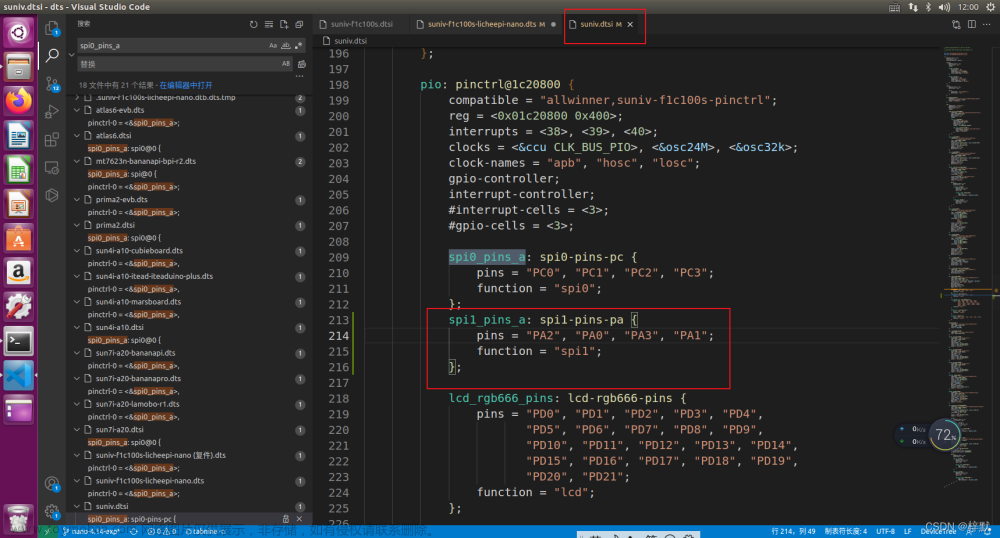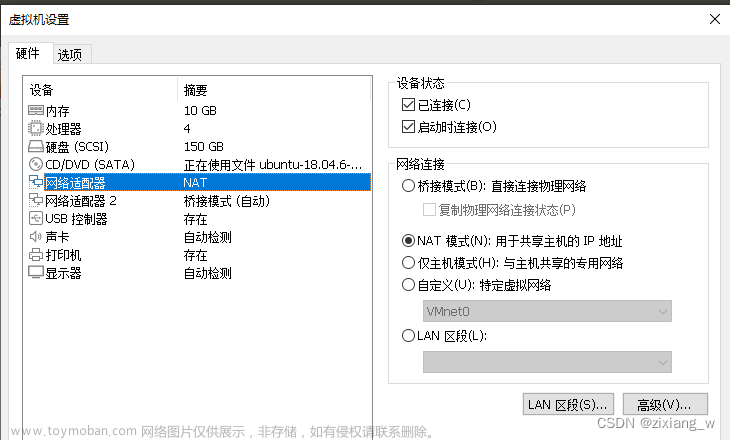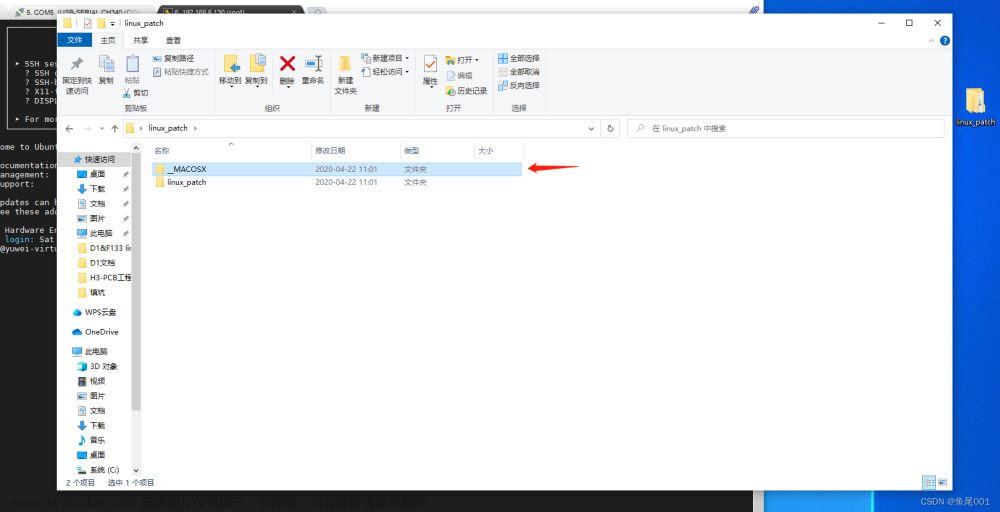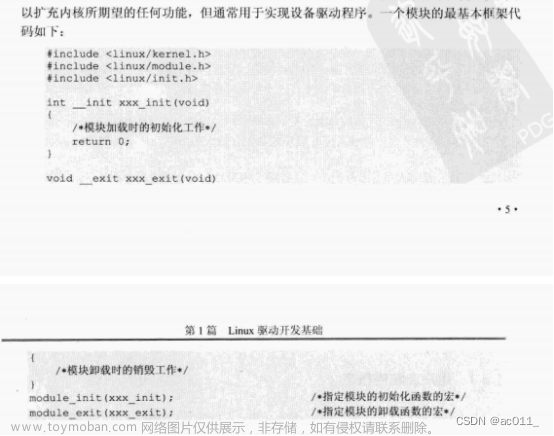基于全志A33开发板linux系统移植学习记录
第一章 Boot0基于ARMGCC的编译与修改
前言
入行快两年,希望通过学习系统移植巩固下相关的知识,目标板使用基于全志A33 的astar-parrot开发板,开始本来想着使用Boot0来加载uboot,但后期发现为了代码统一和便捷性,最终还是选择了SPL作为跳板,但Boot0流程相对清晰,所以将对其做的工作贴出来便于理解。
一、全志A33简介以及上电引导流程
-
硬件方面:A33芯片采用四核基于Cortex- A7架构的处理器,支持高清1080P视频处理,并支持各种主流视频标准,如H.264、VP8、MPEG1/2/4、JPEG/MJPEG,支持RGB/LVDS和LCD接口。256KB一级缓存和512KB二级缓存…
软件方面:适配全志原厂基于openWrt构建的Tina系统:采用uboot2011,Linux3.4版本,可支持Android4.3,
上电流程:
-
芯片支持五种种引导方式,分别是NAND Flash,eMMC NAND,SPI Nor Flash,SD卡(SDC 0/2)和USB。但如果要直接从USB启动系统,由内部上拉50k电阻的UBOOT_SEL引脚需要被拉低。具体引导流程可由下图说明:
-
Soc内部SROM区固化一段代码,上电首先执行这段代码,其主要是判断启动介质并将介质中的部分代码搬运至内部SRAM中(SRAM A1区域,最大32KB,相关控制器已经初始化)并mv PC跳转,判断的顺序就是上图所示。由于目标板使用mmc存储方式,并向外提供了SD卡插槽,为了保证不烧砖(由于移植过程中去掉了fel mode,相对不是很安全),首先利用工具将厂商提供的镜像烧录至mmc(SDC2)中,然后后面利用TF卡,将编译好的bin档dd到sd卡偏移16sector的位置,(SDC0)启动移植代码(SDC0优先级高,所以不会有影响),
二、Boot0编译器修改大致流程
1.Boot0大体流程
根据上述A33的启动方式描述,由于主体u-boot占用内存远远大于其SRAM容量,所以Boot0的主要作用就是运行在SRAM中,初始化启动介质,初始化外部DDR,并搬运uboot到DDR最后跳转。源码github:https://github.com/wangzl-coder/sunxi-basicLoader.git
2.此部分需做的工作
Boot0是比较简单但非常底层的裸机程序,SOC厂商发布的Boot0源码是基于cygwin+armcc进行编译,为了后续的方便,我们需要修改并重新编译,而由于armcc的非开源性,所以第一步是将其转换标准,使用ARM GCC编译方式编译。
3.修改流程
(1)编译环境的搭建部分省略,选用arm通用编译器arm-linux-gnueabi-,首先新建armgcc配置文件,添加如下:
#/*
#*********************************************************************************************************
#* MELIS
#* the Easy Portable/Player Develop Kits
#* Compiler Module
#*
#* (c) Copyright 2006-2010, kevin.z China
#* All Rights Reserved
#*
#* File : crosstool.cfg
#* By : kevin.z
#* Version : v1.0
#* Date : 2010-9-7 10:38
#* Descript: configuration script for RVDS compiler
#* Update : date auther ver notes
#*
#*********************************************************************************************************
#*/
#
#工具链配置
CROSSTOOL = ARMGCC
LICHEEPATH = $(SDKROOT)/../../tools/pack/chips/$(ARCH)
WORKSPACEPATH = $(SDKROOT)/../pack/chips/$(ARCH)
WORKTOOLS = $(SDKROOT)/pctools
ifeq ($(CROSSTOOL), ARMRVDS)
#===============================================================
#RVDS编译器参数配置
#===============================================================
else
ifeq ($(CROSSTOOL), ARMGCC)
#===============================================================
#GNU编译器参数配置
#===============================================================
CROSS_COMPILE ?= arm-linux-gnueabi-
#编译器
CC = $(CROSS_COMPILE)gcc
#编译器参数
CFLAGS =
#打包库
AS = $(CROSS_COMPILE)as
#打包库参数
ASFLAGS =
#链接器
LD = $(CROSS_COMPILE)ld
#链接器参数
LKFLAGS =
#objcopy
OBJCOPY = $(CROSS_COMPILE)objcopy
#加载器参数
OBJCOPY_FLAGS = -O binary -S
else
error:
$(error CROSSTOOL configuration is invalid!!!)
endif
endif
(2) 修改相关文件格式:根据gnuc标准,首先将所有汇编文件后缀修改为.S(大写),将目录标识符"“修改linux格式”/"。
(3)boot0/make.cfg 添加编译,链接参数
ifeq ($(CROSSTOOL), ARMGCC)
#===============================================================================
#使用GNU-GCC编译器
#===============================================================================
CFLAGS += -O2 -Wno-nonnull-compare -fno-strict-aliasing -fno-stack-protector -Werror -Wall $(INCLUDES)
LDFLAGS += -T./config/sun8iw5p1.lds -static
(4)添加链接脚本,_start段作为起始段,将头校验段链接在起始位置,此处首先需要对head自定义段,boot0/Boot0_head.c:
#include "boot0_i.h"
#define DDR3_USED
const boot0_file_head_t BT0_head __attribute__((__section__(".bt0_head")))= {
{
/* jump_instruction */ ( 0xEA000000 | ( ( ( sizeof( boot0_file_head_t ) + sizeof( int ) - 1 ) / sizeof( int ) - 2 ) & 0x00FFFFFF ) ), // one intruction jumping to real code
BOOT0_MAGIC, // ="eGON.BT0" or "eGON.BT1", not C-style string.
STAMP_VALUE, // generated by PC
#ifdef ALIGN_SIZE_8K
0x2000,
#else
0x8000, // generated by PC
#endif
sizeof( boot_file_head_t ), // the size of boot_file_head_t
BOOT_PUB_HEAD_VERSION, // the version of boot_file_head_t
0, // the return value
0, // run addr
EGON_VERSION, // eGON version
{
0, 0, '3','.','1','.','0',0 // platform information
},
},
#ifdef DDR3_USED
{
sizeof( boot0_private_head_t ), // the size of prvt_head
BOOT0_PRVT_HEAD_VERSION, // the version of boot0_private_head_t
/******DRAM patameters for initialising dram. Original values is arbitrary******/
{
/***normal configuration******/
552, //dram_clk
3, //dram_type
0x3bbb, //dram_zq
1, //dram_odt_en
0x10F20200, //dram_para1
0x00, //dram_para2
/****timing configuration*****/
0x1840, //dram_mr0
0x40, //dram_mr1
0x8, //dram_mr2
0, //dram_mr3
0x0048A192, //dram_tpr0
0x01B1B18d, //dram_tpr1
0x00076052, //dram_tpr2
0x0, //dram_tpr3
0x0, //dram_tpr4
0x0, //dram_tpr5
0x0, //dram_tpr6
0x0, //dram_tpr7
0x0, //dram_tpr8
0x0, //dram_tpr9
0x0, //dram_tpr10
0x0, //dram_tpr11
168, //dram_tpr12
0x10900, //dram_tpr13
},
3, // UART控制器编号
{
{ 8, 6, 3, 1, 0xff, 0xff, {0, 0} }, // UART控制器(调试打印口)数据信息 tx
{ 8, 7, 3, 1, 0xff, 0xff, {0, 0} } // UART控制器(调试打印口)数据信息 rx
},
0, // jtag 1 : enable, 0 : disable
{
{ 0, 0, 0, 0, 0, 0, {0, 0} },
{ 0, 0, 0, 0, 0, 0, {0, 0} },
{ 0, 0, 0, 0, 0, 0, {0, 0} },
{ 0, 0, 0, 0, 0, 0, {0, 0} },
{ 0, 0, 0, 0, 0, 0, {0, 0} },
}, // 保存JTAG的全部GPIO信息
{
{ 6, 0, 2, 1, 2, 0, {0, 0} },
{ 6, 1, 2, 1, 2, 0, {0, 0} },
{ 6, 2, 2, 1, 2, 0, {0, 0} },
{ 6, 3, 2, 1, 2, 0, {0, 0} },
{ 6, 4, 2, 1, 2, 0, {0, 0} },
{ 6, 5, 2, 1, 2, 0, {0, 0} }, // 存储设备 GPIO信息
},
/****用户保留数据信息****/
{
0,
}
}
#else
{
sizeof( boot0_private_head_t ),
BOOT0_PRVT_HEAD_VERSION,
{ 0x40000000,
1024,
180,
1,
1,
0,
(__dram_type_e)1,
16,
10,
14,
4,
3,
0,
16,
1024
},
0,
{
{ 2, 22, 4, 1, 1, 0, 0, 0},
{ 2, 23, 4, 1, 1, 0, 0, 0}
},
0,
{ 0 },
{ 0 },
{ 0 }
}
#endif
};
将BT0_head 放入.bt0_head段,链接脚本如下boot0/config/sun8iw5p1.lds:
OUTPUT_FORMAT("elf32-littlearm", "elf32-littlearm", "elf32-littlearm")
OUTPUT_ARCH(arm)
ENTRY(_start)
SECTIONS
{
. = 0x00000000;
. = ALIGN(4);
.head :
{
./Boot0_head.o(.bt0_head)
}
.text :
{
./Boot0.o(.text*)
*(.text*)
}
.data :
{
*(.data*)
}
.rodata :
{
*(.rodata*)
}
.bss :
{
*(.bss*)
}
}
比较简单,主要是为了指定链接参考地址Boot0.o的.text(_start)以及头部数据.bt0_head,bt0_head第一个成员变量将是SROM中mv PC的位置,所以这里放入一个跳转指令0xEA…,指令后面跟当前PC的偏移量(单位为字,所以要除以sizeof(int)),这里要注意流水线问题,由于是三级流水,当前PC指针的位置应该在执行代码地址的两个字后,所以此处需要减去2,通过这个跳转指令可以跳转到head结构体之后的第一个地址(_start)处运行,还有BT0_head这个变量需要在其他任意地方引用一次,否则编译器链接时可能会把它优化掉。
(5)C标准库函数引用问题
可能没有找到合适的编译器版本,在使用C标准库函数(如memset)时,会导致死机的问题,经过后续验证,发现只有在操作字节数大于某些值时才会死机,不明原因,除此还有除法的使用问题,会编译报错,网上查找说链接时需要链接libgcc库,但试了很多方法都不行,所以针对这两个方法只能用最麻烦但是最保险的方式处理
首先针对memset等函数使用问题,摒弃了libc的实现,自己实现这些操作:sunxi-basicLoader/boot0/lib/extra_libc//extra_string.h:
#ifndef __EXTRA_STRING_H__
#define __EXTRA_STRING_H__
#define NULL 0
void *memset(void *s, int val, unsigned int count);
void *memcpy(void *dest, const void *src, unsigned int count);
int strncmp(const char *src1, const char *src2, unsigned int count);
char *strcpy(char *dest, const char *src);
#endif
sunxi-basicLoader/boot0/lib/extra_libc/memcpy.c:
#include "extra_string.h"
void *memcpy(void *dest, const void *src, unsigned int count)
{
char *tmp_dest = NULL;
const char *tmp_src = NULL;
if(dest == NULL || src == NULL)
return NULL;
tmp_dest= (char*) dest;
tmp_src = (const char*) src;
while(count--)
*tmp_dest++ = *tmp_src++;
return dest;
}
sunxi-basicLoader/boot0/lib/extra_libc/memset.c:
#include "extra_string.h"
void *memset(void *s, int val, unsigned int count)
{
char * tmp = NULL;
if(s == NULL)
return NULL;
tmp = (char *) s;
while(count--)
*tmp++ = val;
return s;
}
sunxi-basicLoader/boot0/lib/extra_libc/strcpy.c:
#include "extra_string.h"
char *strcpy(char *dest, const char *src)
{
char * tmp_dest = NULL;
const char * tmp_src = NULL;
if(dest == NULL || src == NULL)
return NULL;
if(dest == src)
return dest;
tmp_dest = dest;
tmp_src = src;
while((*tmp_dest++ = *tmp_src++) != '\0');
return dest;
}
sunxi-basicLoader/boot0/lib/extra_libc/strncmp.c:
#include "extra_string.h"
int strncmp(const char *s1, const char *s2, unsigned int count)
{
int val;
const char *tmp_s1 = NULL;
const char *tmp_s2 = NULL;
if(s1 == NULL || s2 == NULL)
{
return -1;
}
tmp_s1 = s1;
tmp_s2 = s2;
while(count--)
{
if((val = *tmp_s1 - *tmp_s2++) != 0 || *tmp_s1++ == 0)
{
break;
}
}
return val;
}
第二个就是除法的问题,两种处理方式,如果除数是2的n次方,在编译时指定优化等级-O2 ,编译器会将其转换成移位运算(>>n),如果不是,只能采用最原始的方法,将其转换为乘法(由于商值都是整型),例如下面:
mmc->lba = mmc->capacity/mmc->read_bl_len;
可以乘法转换:
while((mmc->read_bl_len * i> mmc->capacity))
{
i++;
}
mmc->lba = i;
(6)头校验:
>前面放在起始位置的head数据主要用于SROM代码的启动校验,主要包括magic字符串以及校验和,由于校验和只能在编译完成后才能计算设定,所以必须要写一个基于主机(Ubuntu等)平台的工具对二进制文本进行操作,添加文件sunxi-basicLoader/pctools/mkboot0.c:
#include <stdio.h>
#include "string.h"
#define STAMP_VALUE 0x5F0A6C39
#define GET_OFFSET(struct_p,child) (unsigned long int)(&(((struct_p *)0x00000000)->child))
typedef struct _boot0_standard_head_t
{
unsigned int jump_instruction; // one intruction jumping to real code
unsigned char magic[8]; // ="eGON.BT0" or "eGON.BT1", not C-style string.
unsigned int check_sum; // generated by PC
unsigned int length; // generated by PC
unsigned int pub_head_size; // the size of boot_file_head_t
unsigned char pub_head_vsn[4]; // the version of boot_file_head_t
unsigned int ret_addr; // the return value
unsigned int run_addr; // run addr
unsigned char eGON_vsn[4]; // eGON version
unsigned char platform[8]; // platform information
}boot0_standard_head_t;
static int func_checkSum(int *buffer,int length)
{
int sum = 0;
int index = 0;
for(index = 0;index < length;index++)
{
sum += buffer[index];
}
return sum;
}
int main(int argc,char* argv[])
{
boot0_standard_head_t boot0_head;
FILE *input_file;
FILE *output_file;
fpos_t input_pos;
int buffer[256];
int read_num = 0;
int write_num = 0;
int write_total = 0;
int sum = 0;
unsigned int headSum_off = 0;
int ret = 0;
if(argc != 3)
{
printf("input param error! \r\n");
return -1;
}
if((input_file = fopen(argv[1],"r")) == NULL)
{
printf("cannot find file %s \r\n",argv[1]);
ret = -1;
goto src_open_failed;
}
if((output_file = fopen(argv[2],"w+")) == NULL)
{
printf("create file %s failed \r\n",argv[2]);
ret = -1;
goto dest_open_failed;
}
if(fread(&boot0_head,sizeof(boot0_head),1,input_file) != 1)
{
printf("read boot0_head not enough! read_num is %d \r\n",read_num);
ret = -1;
goto read_cp_failed;
}
printf("current magic is %s \r\n",boot0_head.magic);
printf("STAMP_VALUE is %x \r\n",boot0_head.check_sum);
printf("current align size is %x \r\n",boot0_head.length);
fseek(input_file,0,SEEK_END);
fgetpos(input_file,&input_pos);
printf("input file size is %ld \r\n",input_pos.__pos);
if(boot0_head.check_sum != STAMP_VALUE)
{
printf("STAMP_VALUE check failed !\r\n");
ret = -1;
goto read_cp_failed;
}
if(boot0_head.length < input_pos.__pos)
{
printf("boot0_head.length too low! \r\n");
ret = -1;
goto read_cp_failed;
}
rewind(input_file);
rewind(output_file);
memset(buffer,0x0,sizeof(buffer));
while((read_num = fread(buffer,1,sizeof(buffer),input_file)) > 0)
{
fwrite(buffer,sizeof(char),read_num,output_file);
write_total += read_num;
sum += func_checkSum(buffer,read_num/sizeof(buffer[0]));
printf("copy file %d bytes \r\n",write_total);
memset(buffer,0x0,sizeof(buffer));
}
if(write_total != input_pos.__pos)
{
printf("write error ! \r\n");
}
if(boot0_head.length > write_total)
{
printf("need add %d bytes 0x0 to the end of %s !! \r\n",boot0_head.length - write_total,argv[2]);
fseek(output_file,0,SEEK_END);
memset(buffer,0x0,sizeof(buffer));
while(1)
{
write_num = ((boot0_head.length - write_total) > sizeof(buffer))?sizeof(buffer):(boot0_head.length - write_total);
fwrite(buffer,1,write_num,output_file);
write_total +=write_num;
if(write_total == boot0_head.length)
break;
}
}
headSum_off = GET_OFFSET(boot0_standard_head_t,check_sum);
printf("mkboot0 success\r\n write to %s total %d bytes ,check_sum is %x \r\n",argv[2],write_total,sum);
fseek(output_file,headSum_off,SEEK_SET);
fwrite(&sum,sizeof(int),1,output_file);
read_cp_failed:
fclose(output_file);
dest_open_failed:
fclose(input_file);
src_open_failed:
return ret;
}
由于SROM根据头部文件结构体的length变量判断加载字节数,这里我们同样判断生成bin文档的length,根据length输出文件,空位补零。gcc编译运行,会将校验和写入结构体对应位置处。
(7)其他细节修改:armgcc编译流程的大体搭建就是这些,当然还有很多细节的东西需要实际编译或者烧录运行时才能发现。
三、Boot0调试
编译通过完成后,生成boot0_sdcard_sun8iw5p1.bin,dd if=boot0_sdcard_sun8iw5p1.bin of=/dev/sdb(根据sd挂载名称) bs=1024 seek=8将其烧录到sd卡第16扇区,插卡上电即可开始调试,前面说到Boot0主要工作就是初始化DDR,加载uboot并跳转,其主要代码如下sunxi-basicLoader/boot0/Boot0_C_part.c:
/*
************************************************************************************************************************
* eGON
* the Embedded GO-ON Bootloader System
*
* Copyright(C), 2006-2008, SoftWinners Microelectronic Co., Ltd.
* All Rights Reserved
*
* File Name : Boot0_C_part.c
*
* Author : Gary.Wang
*
* Version : 1.1.0
*
* Date : 2007.12.18
*
* Description :
*
* Others : None at present.
*
*
* History :
*
* <Author> <time> <version> <description>
*
* Gary.Wang 2007.11.09 1.1.0 build the file
*
* Gary.Wang 2007.12.18 1.1.0 remove "BT0_self_rcv"
*
************************************************************************************************************************
*/
#include "boot0_i.h"
#include "extra_string.h"
#define BOOT_FEL_FLAG (0x5AA5A55A)
extern const boot0_file_head_t BT0_head;
static void clear_ZI( void );
static void print_version(void);
extern unsigned int get_fel_flag(void);
extern void show_rtc_reg(void);
extern void clear_fel_flag(void);
/*******************************************************************************
*函数名称: Boot0_C_part
*函数原型:void Boot0_C_part( void )
*函数功能: Boot0中用C语言编写的部分的主流程
*入口参数: void
*返 回 值: void
*备 注:
*******************************************************************************/
void Boot0_C_part( void )
{
__u32 status;
__s32 dram_size;
int ddr_aotu_scan = 0;
__u32 fel_flag;
// move_RW( );
clear_ZI( );
bias_calibration();
#if defined(CONFIG_ARCH_SUN9IW1P1) || defined(CONFIG_ARCH_SUN8IW6P1)
//do nothing
#else
timer_init();
#endif
UART_open( BT0_head.prvt_head.uart_port, (void *)BT0_head.prvt_head.uart_ctrl, 24*1000*1000 );
if( BT0_head.prvt_head.enable_jtag )
{
jtag_init( (normal_gpio_cfg *)BT0_head.prvt_head.jtag_gpio );
}
msg("HELLO! BOOT0 is starting!\n");
print_version();
#ifdef CONFIG_ARCH_SUN7I
reset_cpux(1);
#endif
fel_flag = get_fel_flag();
show_rtc_reg();
if(fel_flag == BOOT_FEL_FLAG)
{
clear_fel_flag();
msg("eraly jump fel\n");
pll_reset();
__msdelay(10);
jump_to( FEL_BASE );
}
mmu_system_init(EGON2_DRAM_BASE, 1 * 1024, EGON2_MMU_BASE);
mmu_enable();
ddr_aotu_scan = 0;
// dram_para_display();
dram_size = init_DRAM(ddr_aotu_scan, (void *)BT0_head.prvt_head.dram_para);
if(dram_size)
{
//mdfs_save_value();
msg("dram size =%d\n", dram_size);
}
else
{
msg("initializing SDRAM Fail.\n");
mmu_disable( );
pll_reset();
jump_to( FEL_BASE );
}
#if defined(CONFIG_ARCH_SUN9IW1P1)
__msdelay(100);
#endif
#ifdef CONFIG_ARCH_SUN7I
check_super_standby_flag();
#endif
#if SYS_STORAGE_MEDIA_TYPE == SYS_STORAGE_MEDIA_NAND_FLASH
status = load_Boot1_from_nand( ); // 载入Boot1
#elif SYS_STORAGE_MEDIA_TYPE == SYS_STORAGE_MEDIA_SPI_NOR_FLASH
status = load_boot1_from_spinor( ); // 载入Boot1
#elif SYS_STORAGE_MEDIA_TYPE == SYS_STORAGE_MEDIA_SD_CARD
//dram参数拷贝
memcpy((void *)DRAM_PARA_STORE_ADDR, (void *)BT0_head.prvt_head.dram_para, SUNXI_DRAM_PARA_MAX * 4);
status = load_boot1_from_sdmmc( (char *)BT0_head.prvt_head.storage_data ); // 载入boot1
#else
#error The storage media of Boot1 has not been defined.
#endif
msg("Ready to disable icache.\n");
mmu_disable( ); // disable instruction cache
if( status == OK )
{
//跳转之前,把所有的dram参数写到boot1中
set_dram_para((void *)&BT0_head.prvt_head.dram_para, dram_size);
msg("Jump to secend Boot.\n");
jump_to( UBOOT_BASE ); // 如果载入Boot1成功,跳转到Boot1处执行
}
else
{
// disable_watch_dog( ); // disable watch dog
pll_reset();
msg("Jump to Fel.\n");
jump_to( FEL_BASE ); // 如果载入Boot1失败,将控制权交给Fel
}
}
移植的基本思想:先把串口拉起来先跑,有问题处理问题,所以第一步先配置uart,我这里硬件上使用uart3作为调试串口,根据源码追一下uart的初始化,
UART_open( BT0_head.prvt_head.uart_port, (void *)BT0_head.prvt_head.uart_ctrl, 24*1000*1000 );
void UART_open( __s32 uart_port, void *uart_ctrl, __u32 apb_freq )
{
__u32 temp=0, i;
__u32 uart_clk;
__u32 lcr;
volatile unsigned int *reg;
port = uart_port;
// config clock
if(port > 7)
{
return ;
}
reg = (volatile unsigned int *)0x01c2006C;
*reg &= ~(1 << (16 + port));
for( i = 0; i < 100; i++ );
*reg |= (1 << (16 + port));
(*(volatile unsigned int *)0x01c202D8) |= (1 << (16 + port));
// config uart gpio
// config tx gpio
boot_set_gpio((void *)uart_ctrl, 2, 1);
// Set Baudrate
uart_clk = ( apb_freq + 8*UART_BAUD ) / (16*UART_BAUD);
lcr = UART_REG_LCR(port);
UART_REG_HALT(port) = 1;
UART_REG_LCR(port) = lcr | 0x80;
UART_REG_DLH(port) = uart_clk>>8;
UART_REG_DLL(port) = uart_clk&0xff;
UART_REG_LCR(port) = lcr & (~0x80);
UART_REG_HALT(port) = 0;
// Set Lin Control Register
temp = ((PARITY&0x03)<<3) | ((STOP&0x01)<<2) | (DLEN&0x03);
UART_REG_LCR(port) = temp;
// Disable FIFOs
UART_REG_FCR(port) = 0x06;
}
可以看出来,uart初始化使用bt_head成员变量初始化其GPIO以及uart控制器,这里需要配置使用uart的GPIO复用功能,对照芯片手册,uart3 tx使用GPH_6,rx使用GPH_7,在 BT0_head中配置uart:
3, // UART控制器编号
{
{ 8, 6, 3, 1, 0xff, 0xff, {0, 0} }, // UART控制器(调试打印口)数据信息 tx
{ 8, 7, 3, 1, 0xff, 0xff, {0, 0} } // UART控制器(调试打印口)数据信息 rx
},
DDR配置与时序:
/***normal configuration******/
552, //dram_clk
3, //dram_type
0x3bbb, //dram_zq
1, //dram_odt_en
0x10F20200, //dram_para1
0x00, //dram_para2
/****timing configuration*****/
0x1840, //dram_mr0
0x40, //dram_mr1
0x8, //dram_mr2
0, //dram_mr3
0x0048A192, //dram_tpr0
0x01B1B18d, //dram_tpr1
0x00076052, //dram_tpr2
0x0, //dram_tpr3
0x0, //dram_tpr4
0x0, //dram_tpr5
0x0, //dram_tpr6
0x0, //dram_tpr7
0x0, //dram_tpr8
0x0, //dram_tpr9
0x0, //dram_tpr10
0x0, //dram_tpr11
168, //dram_tpr12
0x10900, //dram_tpr13
使用SDC0启动,同样根据芯片手册,配置其GPIO:
{
{ 6, 0, 2, 1, 2, 0, {0, 0} },
{ 6, 1, 2, 1, 2, 0, {0, 0} },
{ 6, 2, 2, 1, 2, 0, {0, 0} },
{ 6, 3, 2, 1, 2, 0, {0, 0} },
{ 6, 4, 2, 1, 2, 0, {0, 0} },
{ 6, 5, 2, 1, 2, 0, {0, 0} }, // 存储设备 GPIO信息
},
期间遇到sd卡驱动失败的问题,调试发现mmc->capacity容量是零,经过很长时间的调试,对照sanDisk的Spc,两者通讯正常且sd卡的相关寄存器都读取正常,发现capacity计算方法出现问题:
while((mmc->read_bl_len * i > mmc->capacity))
{
i++;
}
mmc->lba = i;
这里需要计算sd卡block的数量,应该是capacity有多少个bl_len,所以正确方法应该如下:
while((mmc->read_bl_len * i < mmc->capacity))
{
i++;
}
mmc->lba = i;
一步一步调试之后,直到打印出现sdcard0 init ok说明整个Boot0工作正常,后面对于uboot的操作,由于sd卡中尚未烧录uboot,所以校验失败,后续用移植后的uboot校验,正确跳转并执行,Boot0工作到此结束。文章来源:https://www.toymoban.com/news/detail-403164.html
总结
Boot0代码虽然不是那么的复杂,但移植过程中确实遇到不少麻烦,牵扯到方方面面,虽然后期舍弃了Boot0方式,但是对其调试修改的过程确实能收获不少,后续任务是uboot和linux kernel的操作,加油!文章来源地址https://www.toymoban.com/news/detail-403164.html
到了这里,关于基于全志A33开发板linux系统移植学习记录(Boot0)的文章就介绍完了。如果您还想了解更多内容,请在右上角搜索TOY模板网以前的文章或继续浏览下面的相关文章,希望大家以后多多支持TOY模板网!


![[ARM+Linux] 基于全志h616外设开发笔记](https://imgs.yssmx.com/Uploads/2024/01/419966-1.png)











